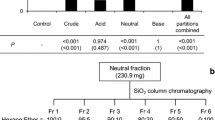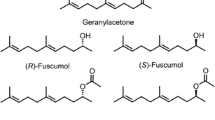Abstract
The elytra of females of the white-spotted longhorn beetle, Anoplophora malasiaca (Coleoptera: Cerambycidae), are coated with a contact sex pheromone, which was previously shown to be composed of at least three chemical groups. Individually, the chemical groups had little pheromonal activity, but a blend of all three exhibited activity equal to that of the crude female extract. Two groups are female-specific aliphatic hydrocarbons and ketones, which were previously synthesized and confirmed to elicit mating behavior. The third group consists of three lactones, gomadalactones A, B, and C, whose chemical structures were previously identified. These have now been synthesized, and the contact sex pheromone activities of synthetic gomadalactones A, B, and C, and the diastereomer of gomadalactone C, were tested in bioassays in this study. When tested in combination with synthetic hydrocarbons and ketones at the same doses as found in female elytra extract, the individual gomadalactones and a blend showed potent pheromonal activity equivalent to that of the crude extract of the elytra of female beetles. This completes the identification of the essential components of the contact sex pheromone of A. malasiaca. Redundancy of components in the hydrocarbon and ketone groups required to elicit mating behavior was observed previously, and this was also true for the gomadalactones.





Similar content being viewed by others
References
Akino T, Fukaya M, Yasui H, Wakamura S (2001) Sexual dimorphism in cuticular hydrocarbons of the white-spotted longicorn beetle, Anoplophora malasiaca (Coleoptera: Cerambycidae). Entomol Sci 4:271–277
Barbour JD, Lacey ES, Hanks LM (2007) Cuticular hydrocarbons mediate mate recognition in a species of longhorned beetle (Coleoptera: Cerambycidae) of the primitive subfamily Prioninae. Ann Entomol Soc Am 100:333–338
Brodie BS, Wickham JD, Teale SA (2012) The effect of sex and maturation on cuticular semiochemicals in Monochamus scutellatus (Coleoptera: Cerambycidae). Can Entomol 144:801–808
Fujiwara-Tsujii N, Yasui H, Wakamura S, Hashimoto I, Minamishima M (2012) White-spotted longicorn beetle, Anoplophora malasiaca (Thomson) (Coleoptera: Cerambycidae), with a blueberry host may utilize original host chemicals for mate location. Appl Entomol Zool 47:103–110
Fukaya M, Yasuda T, Wakamura S, Honda H (1996) Reproductive biology of the yellow-spotted longicorn beetle, Psacothea hilaris (Pascoe)(Coleoptera: Cerambycidae). III. Identification of contact sex pheromone on female body surface. J Chem Ecol 22:259–270
Fukaya M, Akino T, Yasuda T, Tatsuki S, Wakamura S (1999) Mating sequence and evidence for synergistic component in female contact sex pheromone of the white-spotted longicorn beetle, Anoplophora malasiaca (Thomson) (Coleoptera: Cerambycidae). Entomol Sci 2:183–193
Fukaya M, Akino T, Yasuda T, Wakamura S, Satoda S, Senda S (2000) Hydrocarbon components in contact sex pheromone of the white-spotted longicorn beetle, Anoplophora malasiaca (Thomson) (Coleoptera: Cerambycidae) and pheromonal activity of synthetic hydrocarbons. Entomol Sci 3:211–218
Ginzel MD, Millar JG, Hanks LM (2003) (Z)-9-Pentacosene− contact sex pheromone of the locust borer, Megacyllene robiniae. Chemoecology 13:135–141
Ginzel MD, Moreira JA, Ray AM, Millar JG, Hanks LM (2006) (Z)-9-Nonacosene— major component of the contact sex pheromone of the beetle Megacyllene caryae. J Chem Eco 32:435–451
Higuchi T, Saika T, Senda S, Mizobata T, Kawata Y, Nagai J (1997) Development of biorational pest control formation against longicorn beetles using a fungus, Beauveria brongniartii (Sacc.) Petch. J Ferment Bioeng 84:236–243
Lacey ES, Ginzel MD, Millar JG, Hanks LM (2008) 7-Methylheptacosane is a major component of the contact sex pheromone of the cerambycid beetle Neoclytus acuminatus acuminatus. Physiol Entomol 33:209–216
Lingafelter SW, Hoebeke ER (2002) Revision of Anoplophora (Coleoptera: Cerambycidae). Entomological Society of Washington, Washington DC, p 236
Makihara H (2000) True taxonomy and distribution of Anoplophora cerambycid beetles in East Asia. Shinrin-boeki (Forest Pests) 49:180–194 (in Japanese)
Makihara H (2007) Illustrated key & description of Lamiinae. In: Ohbayashi N, Niisato T (eds) Longicorn beetles of Japan: manual with keys and illustrations. Tokai University Press, Tokyo, pp 576–605 (In Japanese)
Mori K (2007) Absolute configuration of gomadalactones A, B and C, the components of the contact sex pheromone of Anoplophora malasiaca. Tetrahedron Lett 48:5609–5611
Muraji M, Wakamura S, Yasui H, Arakaki N, Sadoyama Y, Ohno S, Matsuhira K (2011) Genetic variation of the white-spotted longicorn beetle Anoplophora spp. (Coleoptera: Cerambycidae) in Japan detected by mitochondrial DNA sequence. Appl Entomol Zool 46:363–373
Ohbayashi N (1992) Genus Anoplophora Hope, 1839. In: Ohbayashi N et al (eds) An illustrated guide to identification of longicorn beetles of Japan. Tokai University Press, Tokyo, pp 583–584
Suzuki T, Hagiwara H, Uchida H, Tsujii N, Ono H. (2017) Japan Patent JP2017–095381. https://astamuse.com/ja/published/JP/No/2017095381. (in Japanese). Accessed 1 June 2017
Tanigaki T, Yamaoka R, Sota T (2007) The role of cuticular hydrocarbons in mating and conspecific recognition in the closely related longicorn beetles Pidonia grallatrix and P. takechii. Zool Sci 24:39–45
Yasui H (2009) Chemical communication in mate location and recognition in the white-spotted longicorn beetle, Anoplophora malasiaca (Coleoptera: Cerambycidae). Appl Entomol Zool 44:183–194
Yasui H, Akino T, Yasuda T, Fukaya M, Ono H, Wakamura S (2003) Ketone components in contact sex pheromone of the white-spotted longicorn beetle, Anoplophora malasiaca, and pheromonal activity of synthetic ketones. Entomol Exp Appl 107:167–176
Yasui H, Akino T, Yasuda T, Fukaya M, Wakamura S, Ono H (2007a) Gomadalactones A, B, and C: novel 3-oxabicyclo[3.3.0]octane compounds in the contact sex pheromone of the white-spotted longicorn beetle, Anoplophora malasiaca. Tetrahedron Lett 48:2395–2400
Yasui H, Fujiwara-Tsujii N, Wakamura S (2011) Volatile attractant phytochemicals for a population of white-spotted longicorn beetles Anoplophora malasiaca (Thomson) (Coleoptera: Cerambycidae) fed on willow differ from attractants for a population fed on citrus. Chemoecology 21(2):51-58
Yasui H, Yasuda T, Fukaya M, Akino T, Wakamura S, Hirai Y, Kawasaki K, Ono H, Narahara M, Kousa K, Fukuda T (2007b) Host plant chemicals serve intraspecific communication in the white-spotted longicorn beetle, Anoplophora malasiaca (Thomson) (Coleoptera: Cerambycidae). Appl Entomol Zool 42:255–268
Acknowledgements
We thank Yoshinobu Kiyosue, Kazuhiro Harada, Minoru Narahara, Koji Nakashima, Michiko Goto, Akira Tamanoi, and Yuta Goto of the Oita Prefectural Citrus Experiment Station; Seishi Toda, Shigekatsu Noda, and Yutaka Gyoutoku of the Kumamoto Prefectural Agricultural Research Center; and Shinichi Osaki and Mariko Yoshida of the Uki Agricultural Improvement Extension Center for collecting the insects used in this study. Thanks are also due to Shuko Iwata, Akiko Shimizu, Kazumi Hojo, Taeko Maeda, and Ikuko Hashimoto for assistance with the behavioral bioassays and insect rearing. This project was partially supported by a Grant-in-Aid for Scientific Research (C) (17 K07686) and a Grant-in-Aid for Challenging Exploratory Research (16 K14867) from the Ministry of Education, Culture, Sports, Science and Technology, Japan. We thank Harry Taylor, PhD, and Mallory Eckstut, PhD, from Edanz Group (www.edanzediting.com/ac) for editing drafts of this manuscript.
Author information
Authors and Affiliations
Corresponding author
Rights and permissions
About this article
Cite this article
Fujiwara-Tsujii, N., Yasui, H., Yasuda, T. et al. Contact Sex Pheromone Activity of Synthetic Gomadalactones in Male White-Spotted Longhorn Beetle, Anoplophora malasiaca (Coleoptera: Cerambycidae). J Chem Ecol 45, 440–446 (2019). https://doi.org/10.1007/s10886-019-01069-1
Received:
Revised:
Accepted:
Published:
Issue Date:
DOI: https://doi.org/10.1007/s10886-019-01069-1




